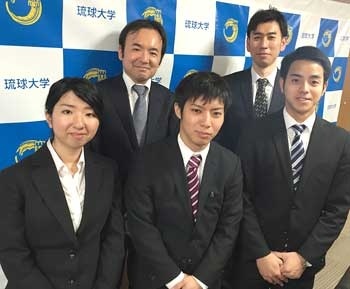University of the Ryukyus contributes 69.4 billion yen to economy

Professor Kouichi Osoguchi (left, second row) with Keiki Murakoso (right, second row) and students from Professor Osoguchi’s seminar calculated the University of the Ryukyu’s economic ripple effect. (Photograph taken on March 30, at University of the Ryukyus in Nishihara Town)
April 8, 2016 Ryukyu Shimpo
The University of the Ryukyus recently researched the economic impact the university has on the local economy. On March 30, they presented their calculation that the economic ripple effect was 69.4 billion yen, with an economic impact ratio of 1.68 times. The economic impact ratio compares the cost of something with what it produces. This is higher than other regional universities in Japan. The research showed that the University of the Ryukyu’s location is helping the local business gain momentum. The findings were presented on March 30. Usually, this type of research is handed over to external consulting companies. However, this time, students majoring in Economics at the Faculty of Law and Letters took on the research themselves, in order to leverage the educational opportunity.
While Ministry of Education, Culture, Sports, Science and Technology (MEXT) pushes through with their University Reform Action Plan, universities are putting in more effort to present their raison d’ être. In fiscal 2015, the University of the Ryukyus established an “Institutional Research Promotion Office” which collects and analyzes data regarding the university’s activities and contributes to this to decision-making at the institution level. It was one of the initiatives of the IR Office to analyze the economic ripple effect of the university.
The measured “direct effects” include purchases of textbooks, research instruments, and research materials, which fall under the “academic and research activities” category. In addition, under “consumption activities of students and faculty,” were food expenses, rent, and other daily necessity expenses. “Other activities” included expenses related to visitors from outside the school and patients from the hospital affiliated with the university. This amounted to 41.4 billion yen. With “ripple effects” such as material procurement and transportation fees, the total added up to 69.4 billion yen within Okinawa.
Kouichi Osoguchi, a professor at the Faculty of Law and Letters and an affiliate of the IR Office, along with staff member Keiki Murakoso, , and five students, who were present at Professor Osoguchi’s seminar, analyzed the data.
Using the general ledger from fiscal 2014 as a basis, the team researched 800 thousand different types of medicines and goods used at the Faculty of Medicine, Faculty of Agriculture, and Faculty of Science. With great patience, they researched everything from the name, discipline, and type of products.
Aika Mori, a junior at the time, is a student leader in the team. She reflected, “I was able to learn practical skills such as sending an e-mail or organizing data.” Professor Osoguchi remarked, “The students were able to take on work at the university level with great responsibility. It’s significant that the students were able to make connections beyond the university walls.”
(English translation by T&CT, Kaya Doi)
Go to Japanese
Previous Article:Editorial: Twenty years wasted since Futenma closure agreement
Next Article:1,500 people stage protest rally 20 years after agreement to close Futenma base
[Similar Articles]
- High costs at OIST, one of the top research universities in the work? Japan’s Ministry of Finance instructs the school to strengthen research results
- Dr. Gruss to be the next president of OIST Graduate University
- Tourism generates 676.7 billion yen in economic ripple effect
- University of the Ryukyus announces policy not to engage in military research
- A 14 percent increase in tourism-related economic effect, record high at 1.17 trillion yen
 Webcam(Kokusai Street)
Webcam(Kokusai Street)


